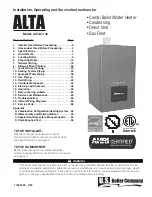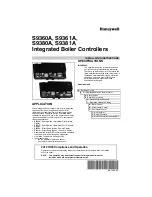
Page
24
of
34
V. Maintenance
A. Cleaning
Wear heavy gloves and clothing and safety glasses as metal, coals and ashes will be hot.
Moisture combined with ash will eat through a boiler in short order and ash corrosion is NOT
covered under warranty.
Clean ash out frequently and stir (break up) ash in
ALL
areas (especially corners) daily to
prevent any “caking” (dense, compacted pockets most often occurring in corners). Caked
up ash holds in moisture and failure to stir ash daily is one of the largest reasons for leaks in
any coal boiler (along with lack of treatment) and neither are covered under warranty.
Caution! Follow procedures as outlined in “Loading Coal” (previous section) for opening the
fuel door.
Close all doors and covers securely once cleaned and follow the procedure in the “Starting A Fire”
section to re-start the boiler if needed.
B. Disposal Of Ashes
Ashes should be placed in a metal container with a tight-fitting lid. The closed container of ashes
should be placed on a noncombustible floor or on the ground, well away from all combustible
materials, pending final disposal. If the ashes are disposed of by burial in the soil or otherwise
locally dispersed, they should be retained in the closed container until all cinders have thoroughly
cooled. Other waste shall not be placed in this container.
C. Creosote - Formation And Need For Removal
When coal is burned slowly, it produces tar and other organic vapors, which combine with expelled
moisture to form creosote. The creosote vapors condense and accumulate in the relatively cool
chimney flue of a slow-burning fire. As a result, creosote residue accumulates on the flue lining.
When ignited this creosote makes an extremely hot fire.
The chimney and any connectors must be inspected at least twice monthly during the heating
season to determine if a creosote buildup has occurred. If creosote has accumulated (3mm or
more) it should be removed to reduce the risk of a chimney fire.
Smaller, more frequent loading and dry, seasoned coal will help limit this. A small and intense fire is
preferable to a large smoldering one to reduce the amount of creosote deposition.
If a soot or creosote fire occurs, keep all doors closed and run the boiler normally until all coal burns
out then shut the boiler down and clean any soot or creosote deposits. Have a clearly understood
plan to handle a chimney fire.
All creosote and ash must be cleaned from the entire boiler frequently as ash mixed with moisture is
very corrosive and will shorten the life of the boiler if not maintained properly. Be aware that the
hotter the fire, the less creosote is deposited, and that weekly cleanings can be necessary in mild
weather, even though monthly cleanings can be enough in the coldest months.
Check frequently for
experience on how often cleaning is necessary (varies by operation, heating demand and coal
quality). Creosote occurs on a larger scale when there is too much moisture content in the coal
being used (green, un-seasoned coal) or from extended idling during milder weather.
D. Fuel Door And Ash Pan Seals
Caution! For inspection and adjustment, make sure to follow the same procedures for
opening doors and covers as outlined for loading and cleaning.
Summary of Contents for NCB-120-COAL
Page 2: ......
Page 4: ......
Page 18: ...Page 18 of 34 ...
Page 32: ...NCB Built Like A Tank With Laser Precision Page 32 of 34 ...
Page 34: ...NCB Built Like A Tank With Laser Precision Page 34 of 34 ...











































